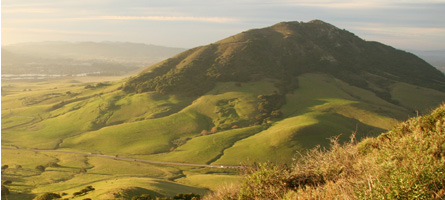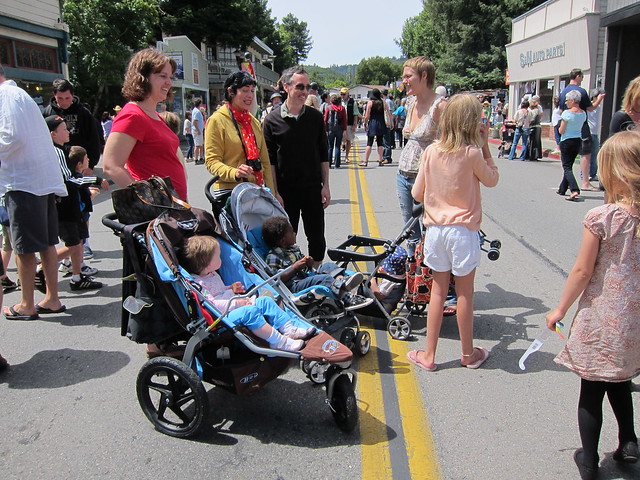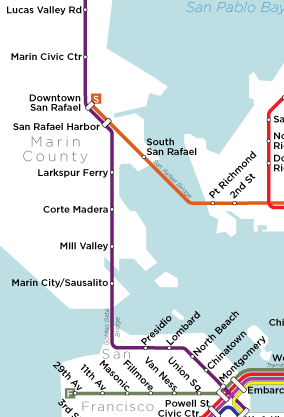![Baltimore [Population: 288,530,000]](http://farm1.staticflickr.com/36/125498077_6a0785e1d8_z.jpg?zz=1) People keep writing about the effectof our urban policies, but very few outside the urbanist blogosphere write about the policies themselves. The articles that result satisfy our curiosity about change but fail to actually inform. They’re all candy, no vegetable. Two articles published last week exemplify this trend. Both describe the effects of the same policies, but both fail to discuss the policies themselves.
The New York Times profiled the blighted rail corridor between New York City and Washington, DC. If you ever travel that stretch of rail, you’ll see boarded up homes, weedy back yards, abandoned factories, and the detritus of a country that’s moved on from its industrial past. In its place has arisen an incestuous service economy built by a New York-Washington axis of power. Anyone with any money has moved to the ‘burbs, leaving the cities behind to rot. At least, that's what the Times' Adam Davidson says.
People keep writing about the effectof our urban policies, but very few outside the urbanist blogosphere write about the policies themselves. The articles that result satisfy our curiosity about change but fail to actually inform. They’re all candy, no vegetable. Two articles published last week exemplify this trend. Both describe the effects of the same policies, but both fail to discuss the policies themselves.
The New York Times profiled the blighted rail corridor between New York City and Washington, DC. If you ever travel that stretch of rail, you’ll see boarded up homes, weedy back yards, abandoned factories, and the detritus of a country that’s moved on from its industrial past. In its place has arisen an incestuous service economy built by a New York-Washington axis of power. Anyone with any money has moved to the ‘burbs, leaving the cities behind to rot. At least, that's what the Times' Adam Davidson says.
Meanwhile, Meredith Galante, writing in Business Insider, wrote glowingly of micro-apartments, tiny homes 160 to 300 square feet. These, it's thought, will help solve the housing crunch in major cities as people flock to city centers and drive rents to the stratosphere. Such homes, according to one entrepreneur, are the future in increasingly overcrowded urban areas.
Wait a second. Anyone with money has moved to the ‘burbs but people with money are so desperate to live in cities that tiny, expensive apartments make sense? Both explanations can’t be right, but both trends are happening anyway. What gives?
Suburbanization, and the policies that encourage it outside and within cities, is to blame. The layers of regulation banning increasing density; the hundreds of billions invested in roads to speed suburbanites into the city in cars; the parking lots to store all those cars that destroyed buildings and the city’s fabric; and the zoning codes that locked uses into place have released bizarre forces on cities. Where suburbanization has been restrained, city living is so valuable but so difficult to accommodate that housing is squeezed into every nook and cranny of developable space, and there's not a lot of that. Where suburbanization runs rampant, cities collapse under the weight of regulation and outright destruction.
Micro-apartments in the Boom Towns
Zoning, that can be the most destructive by banning reinvention of place. Regulations dictate exactly what kind of building can be built, how many people can live there, what kind of business you can open, how many parking space you must have, how far back the building must be from the property lines, and on and on.
To amend the zoning code requires going through homeowners zealously protective of the status quo. Consideration of legalizing in-law units incites howls of protest that such plans would destroy the neighborhood. Even in New York, the idea of allowing taller buildings in Midtown Manhattan has caused consternation and hand-wringing over whether they would, yes, destroy the neighborhood.
It wasn’t always so. In the 1910s, Manhattan’s West Side was all mansions; by the 1930s, it was apartment blocks. The wealthy had found other places to put mansions, and the city was growing so rapidly that allowing one family to occupy a half-acre of land was unacceptably expensive. Putting a hundred families in its place ensured that new housing satisfied the extremely high demand. Apartments along San Rafael’s D Street are the result of the same process. Sprinkled among single-family homes, the apartment buildings provide valuable housing for those who want to live close to Marin’s urban heart.
Now, the places where development can happen become ever more rare, and stiff design review processes ensure that it will take huge sums of money and sometimes years to pass just one project. It’s no wonder there’s a housing shortage - we have the political brakes on so hard we can't move anywhere near fast enough. Micro-apartments, which allow the most units to be squeezed into the city's apartment production line, are the inevitable result of supply constrained on every side.
Cities We Leave Behind (Every Day)
In the blighted cities described by the Times, policies designed to facilitate the suburbs accelerated declines from prominence. Loans and tax deductions favored single-family homes, single-use zoning isolated residences from business from office, and superhighways encouraged anyone with money to leave cities behind. It didn't help that those superhighways destroyed huge swathes of cities and shut out downtowns from the nearby neighborhoods.
The trigger for the exodus in many of the cities between Washington and New York were race riots in the 1960s. Angry mobs tore through businesses and destroyed the livelihoods of millions. Even DC was not immune; the current population boom mostly involves repopulating the burned-over areas that had rotted for decades. New freeways built over the poorest neighborhoods whisked people between their new homes in the ‘burbs and their old jobs in ossified office districts, zoned and reserved for the needs of car-based office workers. Even today, those workers leave their cities behind to fend for themselves on a daily basis.
Now that we want to reinvest in our center cities, the priorities of the car-driving suburbanite still take precedence. Requiring developers to build a certain amount of parking spaces, for example, is extremely common in American cities. Unfortunately, the practice has little basis in science and does quite a bit of harm. It reduces the viability of projects by forcing the construction of excess spaces, hurts the streetscape by putting more cars on the road and lining sidewalks with parking rather than retail. At the very least it means investments in on-street bicycling are rejected because of reductions in on-street parking or in the number of lanes on a street. Dedicated transit lanes and freeway demolitions are often rejected for the same reason.
Yet this is The Greater Marin, a blog about a suburb, and it may seem out of step to advocate for keeping Marin’s low-rise towns while excoriating cities for bowing to the needs of the people that live in those low-rise towns. I don’t think it is.
Novato has zoning rules that ban banks from facing Grant Avenue, forcing the new Umpqua Bank branch to face a parking lot instead of the sidewalk. San Anselmo's zoning bans bike shops from San Anselmo Avenue, though clearly the rule is happily ignored. San Rafael forces downtown residences to build parking on-site while city-owned parking garages sit half-empty. These restrictions hurt our towns, businesses, and both current and potential residents. It’s not just the big cities that are hurt by unexamined rules; we are, too.
When articles tout micro-apartments as the Next Big Thing or bemoan the decline of the industrial city without a policy discussion, they do a disservice. They gloss over the causes that created and perpetuate these trends, providing easy answers in place of honest critique. It wasn't just industrial decline that wrecked the cities of the Northeast; suburbanization did. It's not that young people want to live in tiny apartments; zoning forces them to trade living space for location. Avoiding discussions like this is bad for San Francisco, bad for the Northeast, and, ultimately, bad for Marin. The Times and Business Insider should know better.
 Last Thursday, the IJ published an editorial defending the Grady Ranch affordable housing project from critics. If we don't know what the project will look like, asks the editorial board, how can we criticize? Perhaps it will include a bike lane and sidewalks all the way to 101. Perhaps there will be a place for Marin Transit to run a shuttle, never mind the cost. And perhaps there will be a small grocery store so residents will be able to do at least one errand without getting in the car.
Last Thursday, the IJ published an editorial defending the Grady Ranch affordable housing project from critics. If we don't know what the project will look like, asks the editorial board, how can we criticize? Perhaps it will include a bike lane and sidewalks all the way to 101. Perhaps there will be a place for Marin Transit to run a shuttle, never mind the cost. And perhaps there will be a small grocery store so residents will be able to do at least one errand without getting in the car.
![Baltimore [Population: 288,530,000]](http://farm1.staticflickr.com/36/125498077_6a0785e1d8_z.jpg?zz=1)





